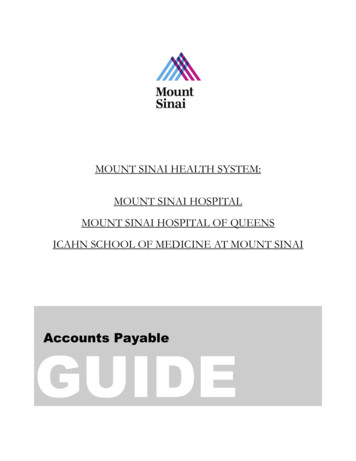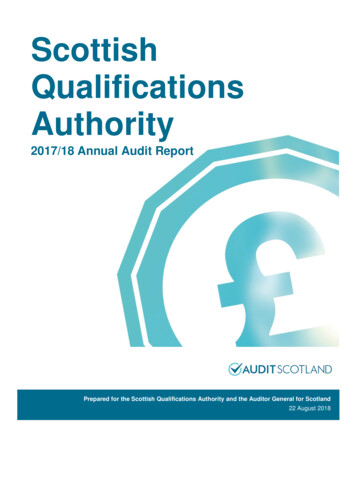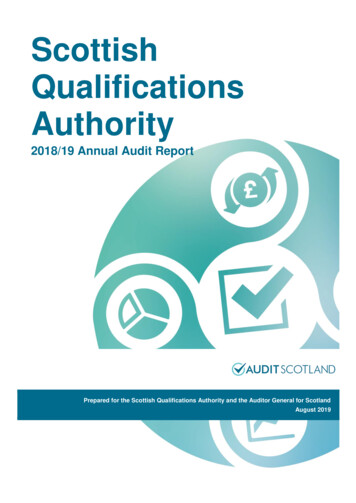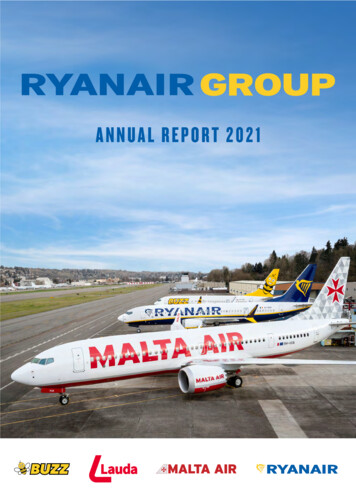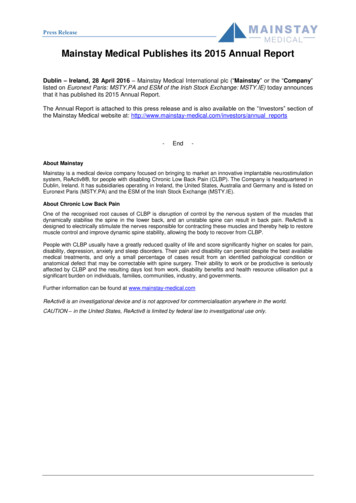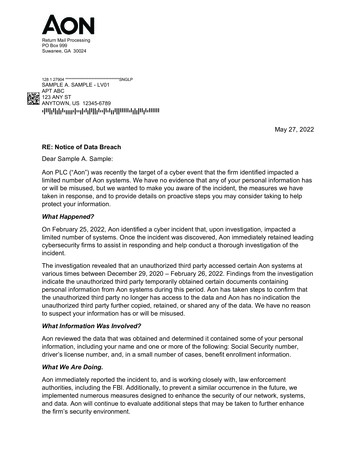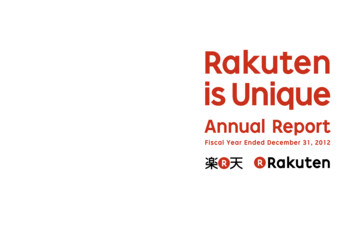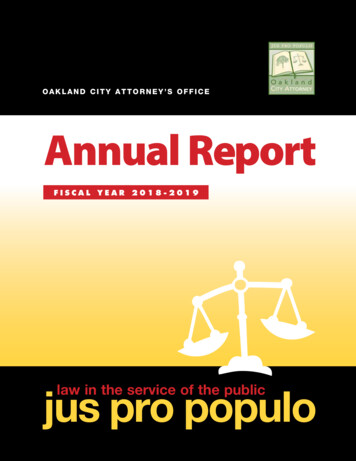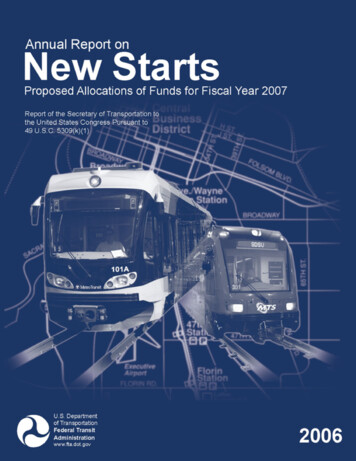
Transcription
Annual Report onNew StartsProposed Allocations of Fundsfor Fiscal Year 2007Report of the Secretary of Transportationto the United States CongressPursuant to 49 U.S.C. 5309(k)(1)2006Prepared by:Federal Transit AdministrationPursuant to:Title 49, United States Code, Section 5309(k)(1)Available from:Federal Transit AdministrationOffice of Planning and Environment400 7th Street, SW, Room 9413Washington, DC 20590http://www.fta.dot.gov(Cover Photos courtesy of Metro Transit, Minneapolis, MN, San Diego Association ofGovernments, San Diego, CA, and Sacramento Regional Transit District, SacramentoCA)
Annual Report on New Starts2006Table of ContentsExecutive Summary . 1Introduction . 3Principles for Funding Recommendations. 4A Word about Full Funding Grant Agreements. 5FY 2007 Funding Allocations and Recommendations. 7Existing Full Funding Grant Agreements . 7Pending Full Funding Grant Agreements . 7NY, New York, Long Island Rail Road East Side Access. 7PA, Pittsburgh, North Shore LRT Connector . 8Proposed Full Funding Grant Agreements. 9CO, Denver, West Corridor LRT. 9OR, Portland, South Corridor I-205 / Portland Mall LRT . 10OR, Washington County, Wilsonville to Beaverton Commuter Rail . 11TX, Dallas, Northwest/Southeast LRT MOS. 11UT, Salt Lake City, Weber County to Salt Lake City Commuter Rail. 12Other Projects. 13Washington D.C. Metropolitan Area, Largo Metrorail Extension. 13NY, New York, Second Avenue Subway MOS . 14VA, Norfolk, Norfolk LRT . 15VA, No. Virginia/Dulles Corridor Metrorail Project – Extension to Wiehle Avenue . 16WA, Seattle, University Link LRT Extension . 17Small Starts . 18Other Funding . 18Transportation in the Parks and Public Lands Program. 19FY 2007 New Starts Projects and Ratings Contained in this Report . 20Appendix A: New Starts Project Profiles . A-1Appendix B: FY 2007 Evaluation and Rating Process . B-1Proposed Allocations of Funds for FY 2007i
Annual Report on New Starts2006Alphabetical List of A-LUTEA-21STPUSCYOEiiNameAlternatives AnalysisAdvanced Notice of Proposed RulemakingBus Rapid TransitCentral Business DistrictCongestion Mitigation and Air QualityDepartment of TransportationEnvironmental AssessmentEnvironmental Impact StatementEnvironmental Protection AgencyFinding of No Significant ImpactFull Funding Grant AgreementFederal Transit AdministrationFiscal YearIntermodal Surface Transportation Efficiency Act of 1991Heavy Rail TransitLocally-Preferred AlternativeLight Rail TransitMajor Investment StudyMinimum Operable SegmentNational Environmental Policy ActNotice of Proposed RulemakingPreliminary EngineeringProject Construction Grant AgreementRight-of-WaySafe, Accountable, Flexible, Efficient TransportationEquity Act: A Legacy for Users (2005)Transportation Equity Act for the 21st Century (1998)Surface Transportation ProgramUnited States CodeYear of ExpenditureProposed Allocations of Funds for FY 2007
Annual Report on New Starts2006Executive SummaryThis report provides the U.S. Department of Transportation’s recommendations to Congress forthe allocation of funds for the design and construction of fixed guideway New Starts and “SmallStarts” capital investments for fiscal year (FY) 2007. These programs are part of the CapitalInvestment Grant Program provisions of 49 USC 5309, most recently reauthorized by the Safe,Accountable, Flexible, Efficient Transportation Equity Act: A Legacy for Users (SAFETEA-LU)in August 2005. As required by SAFETEA-LU, this report also contains a summary of theallocation of funds made available to assist qualified projects under the AlternativeTransportation in the Parks and Public Lands Program under 49 USC 5320.The Federal Transit Administration’s (FTA) discretionary New Starts program is the Federalgovernment’s primary financial resource for supporting locally-planned, implemented, andoperated major transit capital investments. From heavy to light rail, from commuter rail to busrapid transit systems, the New Starts program has helped to make possible hundreds of new orextended transit fixed guideway systems across the country. These rail and bus investments, inturn, have improved the mobility of millions of Americans, have helped to reduce congestion andimprove air quality in the areas they serve, and have fostered the development of more viable,safe, and livable communities.The President’s Budget for FY 2007 proposes 1,466 million for the capital investment grantprogram under Section 5309. A total of 1,229.48 million is recommended for 16 existing, twopending, and five proposed Full Funding Grant Agreements (FFGA). A total of 101.86 millionis proposed for four projects that are anticipated to be in final design by the Spring of 2006,pending resolution of outstanding issues, and for additional rail cars to be added to the completedLargo Metrorail Extension (metropolitan Washington D.C.) FFGA. A total of 100 million isrecommended for the new Small Starts program. Finally, a total of 34.66 million isrecommended for specific ferry projects, statutory funding to support the work of the DenaliCommission, and New Starts oversight activities.The pending and proposed FFGAs include projects that will likely be eligible and ready for anFFGA prior to or during FY 2007, and are presented below:Pending FFGAs Long Island Rail Road East Side Access, New York, New YorkNorth Shore Light Rail Transit Connector, Pittsburgh, PennsylvaniaProposed FFGAs West Corridor LRT, Denver, ColoradoSouth Corridor I-205/Portland Mall LRT, Portland, OregonWilsonville to Beaverton Commuter Rail, Washington County, OregonNorthwest/Southeast LRT MOS, Dallas, TexasWeber County to Salt Lake City Commuter Rail, Salt Lake City, UtahFTA proposes FY 2007 funding for five other projects. Four of these projects are not advancedto the point of being considered for an FFGA at this time, but demonstrate that they are makingProposed Allocations of Funds for FY 20071
Annual Report on New Starts2006progress towards consideration for an FFGA in the near future. Each of these four projects israted Medium or higher; possesses a Medium or better cost effectiveness rating or is exemptedfrom the requirement for a Medium cost effectiveness rating; and is expected to be in final designby the Spring of 2006, pending resolution of outstanding issues. These projects are as follows: Second Avenue Subway MOS, New York, NYDulles Corridor Metrorail Project - Extension to Wiehle Avenue, Northern VirginiaNorfolk LRT, Norfolk, VAUniversity Link LRT Extension, Seattle, WAThe fifth project is the Largo Metrorail Extension, which completed an FFGA in FY 2005 andbegan revenue service in December 2004. Section 3043(a)(31) and 3043(j) of SAFETEA-LUauthorizes the inclusion of an additional 52 rapid rail cars in the Largo Metrorail ExtensionFFGA. By this mandate, FTA has included the Largo Metrorail Extension in this fundingcategory, even though the original FFGA has been completed and revenue service for this projecthas begun.These project recommendations, as well as the funding reserved for Small Starts, ferry projects,the Denali Commission, and project management oversight, form the basis of the President’sannual budget submission for the New Starts program. All funding for the New Starts programis subject to the annual Federal appropriations process.SAFETEA-LU Section 3021(a), which added Section 5320 to title 49 of the United States Code,established a new program to fund alternative transportation projects in national parks and publiclands. Section 5320 stipulates that the Secretary of Transportation annually submit a report onthe allocation of amounts made available to assist qualified projects under this section, and thatthis information is to be included in the Annual Report on New Starts submitted under Section5309(k)(1). In December 2005, Congress appropriated 22 million for the AlternativeTransportation in the Parks and Public Lands program for FY 2006, consistent with fundinglevels authorized in SAFETEA-LU. At the time of this publication, the allocation of these fundswas not yet determined by the Department of Transportation and the Department of the Interior.It is anticipated that the FY 2008 Annual Report on New Starts will include a report on the fundsallocated under Section 5320 once projects have been selected.2Proposed Allocations of Funds for FY 2007
Annual Report on New Starts2006IntroductionThis report provides the U.S. Department of Transportation’s recommendations to Congress forthe allocation of funds for the construction of new fixed guideway systems and extensions(49 USC 5309(d) – Major Capital Investment Grants of 75,000,000 or More, or “New Starts,”and 49 USC 5309(e) – Capital Investment Grants of Less Than 75,000,000 or “Small Starts”)for fiscal year (FY) 2007. The Annual Report on New Starts for FY 2007 is a collateraldocument to the President’s annual budget submission to Congress. It is important in theadministration of the Federal transit assistance program, and improves the information exchangebetween the Executive and Legislative branches at the beginning of an appropriations cycle forthe next fiscal year.The mandate for the Annual Report on New Starts is a continuation of provisions first establishedby the Transportation Equity Act for the 21st Century (TEA-21) in 1998 and reauthorized by theSafe, Accountable, Flexible, Efficient Transportation Equity Act: A Legacy for Users(SAFETEA-LU), signed into law on August 10, 2005. SAFETEA-LU made some changes tothe New Starts program, including the creation of a new sister program (Small Starts) for capitalinvestment grants of less than 75 million.The President’s Budget for FY 2007 proposes 1,466 million for the capital investment grantprogram under Section 5309. A total of 1,229.48 million is recommended for 16 existing, twopending, and five proposed Full Funding Grant Agreements (FFGA). A total of 101.86 millionis proposed for four projects that are anticipated to be in final design by the Spring of 2006,pending resolution of outstanding issues, and for additional rail cars to be added to the completedLargo Metrorail Extension (metropolitan Washington D.C.) FFGA. A total of 100 million isrecommended for the new Small Starts program. Finally, a total of 34.66 million isrecommended for specific ferry projects, statutory funding to support the work of the DenaliCommission, and New Starts oversight activities. See Table 1 on page 6 for funding details onthese recommendations.In addition to funding recommendations, Appendix A of the FY 2007 Annual Report on NewStarts provides the status of 16 existing FFGA projects currently under construction; detailedresults of FTA’s evaluation of the merit and local financial commitment of 20 major capitalinvestment projects in preliminary engineering (PE) and final design; and brief summaries of thestatus of four projects in PE or final design which are requesting less than 25 million in NewStarts funding and therefore exempt from the New Starts evaluation process. Appendix Bdescribes the measures, rating breakpoints, and overall process followed by FTA for evaluatingprojects currently in PE and final design which are pursuing an FFGA.FTA is currently working with stakeholders and grantees to issue a joint Small Starts/New StartsNotice of Proposed Rulemaking in September 2006, with a Final Rule to be published inmid-2007. As a first step, FTA published in January 2006 policy guidance on the projectevaluation process that FTA intends to follow for fiscal year 2008 budget recommendations.With input from stakeholders from around the country through both formal and informallistening sessions and discussions, FTA also published an Advanced Notice of ProposedRulemaking (ANPRM) on the Small Starts subprogram in early 2006. The ANPRM acts as atesting document to raise pertinent issues for discussion with stakeholders. As rulemaking is stillin progress at the time of publication of the President’s FY 2007 annual budget, FTA hasbudgeted 100 million of the Small Starts funding authorized by Congress for FY 2007 withoutProposed Allocations of Funds for FY 20073
Annual Report on New Starts2006recommending funding for any specific projects. If worthy Small Starts projects emerge over thenext several months, FTA may make project-specific recommendations when Congress isconsidering its FY 2007 appropriations decisions.Principles for Funding RecommendationsThe funding recommendations in this report are the result of an extensive project developmentand evaluation process, which is described in detail in Appendix B to this report. To be eligiblefor an FTA funding recommendation, proposed New Starts projects must complete theappropriate steps in the planning and project development process and, per SAFETEA-LU,receive an overall project rating of Medium or higher.SAFETEA-LU replaced the three-level project rating scale of “Highly Recommended,”“Recommended,” and “Not Recommended” established by TEA-21 with a five-level scale of“High,” “Medium-High,” “Medium,” “Medium-Low,” and “Low.” SAFETEA-LU furtherrequires that only those projects rated Medium or higher may be recommended for funding.However, it must be noted that project ratings are intended only to reflect the “worthiness” ofeach project, not the “readiness” of a project for an FFGA or other funding recommendation.Proposed projects that are rated Medium or higher will be eligible for multi-year fundingrecommendations in the President’s budget if funding is available and the candidate project’sproposed scope, cost estimate, and budget are considered final. In addition, notwithstandingtheir overall project rating, FTA will not generally recommend for funding any project whichdoes not achieve a rating of at least Medium for cost effectiveness, unless the project has beenexempted from this policy.When recommending annual funding allocations among proposed New Starts projects, FTAapplies the following general principles:4 Any project recommended for new funding commitments should meet the projectjustification, finance, and process criteria established by Sections 5309(e) and5309(d) and be consistent with Executive Order 12893, Principles for FederalInfrastructure Investments, issued January 26, 1994. Existing FFGA commitments should be honored before any additional fundingrecommendations are made, to the extent that funds can be obligated for theseprojects in the coming fiscal year. The FFGA defines the terms of the Federal commitment to a specific project,including funding. Upon completion of an FFGA, the Federal funding commitmenthas been fulfilled. Additional project funding will not be recommended. Anyadditional costs beyond the scope of the Federal commitment are the responsibility ofthe grantee, although FTA works closely with grantees to identify and implementstrategies for containing capital costs at the level included in the FFGA at the time itwas executed. Funding for initial planning efforts such as alternatives analysis is no longer eligiblefor Section 5309 funding under SAFETEA-LU, but may be provided through grantsunder the Section 5303 Metropolitan Planning or Section 5307 Urbanized AreaFormula programs or from the newly created Section 5339 Alternatives Analysisprogram.Proposed Allocations of Funds for FY 2007
Annual Report on New Starts2006 Firm funding commitments, embodied in FFGAs, will not be made until projectsdemonstrate that they are ready for an FFGA, i.e. the final design process hasprogressed to the point where the project scope, costs, benefits, and impacts areconsidered firm and final. Funding should be provided to the most worthy investments to allow them to proceedthrough the process on a reasonable schedule, to the extent that funds can beobligated to such projects in the upcoming fiscal year. Funding decisions will bebased on the results of the project evaluation process and resulting finance,justification, and overall ratings.FTA emphasizes that project evaluation and rating is an on-going process. As proposed NewStarts projects proceed through the project development process, information concerning costs,benefits, and impacts is refined and the ratings may be reassessed to reflect new information.A Word about Multi-Year Funding Grant AgreementsFTA and sponsors of New Starts projects enter into a multi-year contractual agreement thatformally establishes the maximum level of Federal financial assistance and outlines the termsand conditions of Federal financial participation. For projects requiring 75 million or more inNew Starts funding, the agreement is called a Full Funding Grant Agreement (FFGA). Forprojects requiring less than 75 million in New Starts funding with a total project cost of lessthan 250 million, the agreement is called a Project Construction Grant Agreement (PCGA).The FFGA/PCGA defines the project, including cost, scope, and schedule; commits to amaximum level of New Starts financial assistance (subject to appropriation); establishes theterms and conditions of Federal financial participation; defines the period of time for completionof the project; and helps FTA and the project sponsor manage the project in accordance withFederal law.The FFGA/PCGA assures the grantee of predictable Federal financial support for the project(subject to Congressional appropriations), while placing a limitation on the amount of thissupport. Thus, an FFGA/PCGA limits the exposure of the Federal government to cost increasesthat may result if project design, engineering, and/or project management is not adequatelyperformed at the local level. While FTA is responsible for ensuring that planning projections arebased on realistic assumptions and that design and construction follow acceptable industrypractices, it is the responsibility of project sponsors to properly manage, design, engineer andconstruct projects. FTA is not directly involved in the design and construction of NewStarts/Small Starts projects but does utilize its Project Management Oversight Program to obtainindependent feedback on project status and progress, including the establishment of scope,budget, and schedule, as well as provide guidance on management, construction, and qualityassurance practices.Additional information and guidance on developing FFGAs is contained in further detail in FTACircular 5200.1A, Full Funding Grant Agreements Guidance, dated December 5, 2002, and theFTA Rule on Project Management Oversight (49 CFR Part 633). More details, as well as theopportunity to help FTA further define the Small Starts PCGA development process, will beprovided in the coming months through the rulemaking process.Proposed Allocations of Funds for FY 20075
6WashingtonNew YorkNorthern VirginiaNorfolkSeattleDenverPortlandWashington CountyDallasSalt Lake mMedium 0 53,905,500 468,345,947 00 24,502,50029,403,00000 40,184,100 4,900,500014,701,50011,761,2008,820,900 387,139,500 333,234,00053,905,500 733,667,899 ,408,000 1,246,158,272 (1, 2) 9,27314,701,5004,900,500FY 2006 Enacted 260,300,000 (8) 8,915,549186,231,36412,899,0340 48,903,04922,911,522 0016,561,7279,429,800 349,520,939(5)(6)(7)(4)(3)Notes1. Total does not reflect total FY 2006 Appropriations of 1,487,970,000 which includes projects not recommended for FY 2007 funding.2. Funding for oversight has been deducted from each listed project in FY2006 and FY2005 and previous funding3. Does not include 3,873,958 in prior year funds not included in FFGA.4. Does not include 3,880,000 for MIS and funds used for North Corridor and Rock Hill to Charlotte5. Does not include 2,500,000 in prior year funds not included in FFGA.6. Does not include 5,958,137 in prior year funds not included in FFGA.7. Does not include 4,962,500 in prior year funds not included in FFGA.8. Project completed original FFGA funding in FY2005, however SAFETEA-LU authorized the inclusion of funding for additional rail vehicles.Total Small StartsTotal Other ProjectsOther ProjectsLargo Metrorail ExtensionDCNYSecond Avenue Subway MOSVADulles Corridor Metrorail Project-Extension to Wiehle Ave.VANorfolk LRTWAUniversity Link LRT ExtensionTotal Proposed Full Funding Grant AgreementsProposed Full Funding Grant AgreementsWest Corridor LRTCOORSouth Corridor I-205/Portland Mall LRTORWilsonville to Beaverton Commuter RailTXNorthwest/Southeast LRT MOSUTWeber County to Salt Lake City Commuter RailTotal Pending Full Funding Grant AgreementsMediumMedium 254,532,82694,988,113New YorkPittsburgh 96,853,954244,145,265Pending Full Funding Grant AgreementsNYLong Island Rail Road East Side AccessPANorth Shore LRT FGAFFGAFFGAFFGAFFGAFFGA 3,286,631,999PhoenixLos AngelesSan DiegoSan DiegoSan otteNorthern NJClevelandPortlandSan JuanSeattleTotal Existing Full Funding Grant AgreementsExisting Full Funding Grant AgreementsAZCentral Phoenix/East Valley Light RailCAMetro Gold Line Eastside ExtensionCAMission Valley East LRT ExtensionCAOceanside-Escondido Rail CorridorCABART Extension to San Francisco AirportCOSoutheast Corridor LRTILDouglas Branch ReconstructionILRavenswood Line ExtensionILUnion-Pacific West Line ExtensionMDCentral LRT Double-TrackNCSouth Corridor LRTNJHudson-Bergen MOS-2OHEuclid Corridor Transportation ProjectORInterstate MAX LRT ExtensionPRTren UrbanoWACentral Link Initial Segment 4,177,991,934 (2)FY 2005 and PreviousFundingGRAND TOTALOverall ProjectRating ,380,00010,210,000N/AAreaTotals by PhaseExisting Full Funding Grant AgreementsPending FFGAsProposed FFGAsOther ProjectsSmall StartsOversight ActivitiesFerry Capital Projects (AK or HI)Denali CommissionProjectTable 1 - FY 2007 Funding for New Starts 3542,9402,670,51880,000,000 1,466,000,000 0,00014,660,00015,000,0005,000,000FY 2007 Request 849,211,557 55,192,99500097,446,735 849,211,557Remaining FFGAFunding 5,441,389,854 00307,409,854500,000,000 5,441,389,854Total FFGAFundingAnnual Report on New Starts2006Proposed Allocations of Funds for FY 2007
Annual Report on New Starts2006FY 2007 Funding Allocations and RecommendationsThe President’s Budget for FY 2007 proposes 1,466 million for the capital investment grantprogram under Section 5309. A total of 1331.34 million is recommended for existing orpending Full Funding Grant Agreements (FFGAs), proposed FFGAs, and several other projects.In addition, 100 million is recommended for the new Small Starts program. Finally, 34.66 million is recommended for specific ferry projects, statutory funding to support the workof the Denali Commission, and New Starts program management oversight activities.Existing FFGAsSixteen projects have existing FFGAs that commit FTA to request from Congress a specifiedlevel of major capital investment funding in a given fiscal year, based on the budget andschedule for the project. The schedule of Federal funding over the span of the FFGA is listed inAttachment 6 of these FFGAs. FTA has reviewed the progress of each of these 16 projects andis requesting 571.88 million, which is the full amount reflected in Attachment 6 for theseprojects for FY 2007. Descriptions of each of these projects can be found in Appendix A.Pending FFGAsTwo projects are currently pending issuance of an FFGA: the Long Island Rail Road East SideAccess project in New York, New York, and the North Shore Light Rail Transit (LRT)Connector in Pittsburgh, Pennsylvania. Both projects are rated Medium. For these two projects,FTA recommends a total of 355.00 million in New Starts funding in FY 2007. The fundingrecommendations for these projects reflect the proposed funding level in the unexecuted FFGAsas currently drafted. Appendix A provides a detailed description of both projects, includingtheir most recent New Starts rating.New York: New York, Long Island Rail Road East Side AccessThe Metropolitan Transportation Authority (MTA) and the Long Island Rail Road (LIRR)propose to construct a new direct 3.5-mile commuter rail extension from LIRR’s Main and PortWashington Branch Lines in Long Island and Queens, to Grand Central Terminal (GCT) onManhattan’s East Side. The project includes the construction of a new station in the Sunnysidearea of Queens, and new tunnels beneath Sunnyside Yard connecting to the currently unusedlower level of the 63rd Street Tunnel beneath the East River. In Manhattan, the project wouldcontinue west beneath 63rd Street and towards Park Avenue under the Lexington Avenuesubway, turning south beneath the existing MTA-Metro North Railroad tracks under ParkAvenue to a new LIRR passenger concourse in the lower level of GCT. At GCT, the projectwould provide new tracks, platforms, waiting areas, ticket windows, and other services.The current highway system and East River crossings (bridges and tunnels) to Manhattan fromNassau/Suffolk (and parts of eastern Queens) are at capacity and subject to severe congestionand long delays. Expansion of the highway network is not feasible due to lack of availablerights-of-way, high costs, and potentially adverse environmental impacts in a “severe” nonattainment area for ozone. The LIRR operates at capacity in this area with peak service of 37trains per hour into its only Manhattan terminal at Penn Station. Nearly half of LIRR’s 106,000existing daily riders have destinations on Manhattan’s East Side, and currently spendapproximately 20 minutes “doubling back” from Penn Station on the island’s West Side.Without the project, future LIRR trains to Penn Station will be severely congested, and areprojected to operate at 27 percent over their passenger-carrying capacity. This level of crowdingand discomfort would discourage or prevent new riders from using the LIRR to reach Manhattan.Proposed Allocations of Funds for FY 20077
Annual Report on New Starts2006By redirecting trains to GCT, this congestion would be relieved and added capacity for Amtrakand New Jersey Transit service would be created at Penn Station.MTA/LIRR completed a Final Environmental Impact Statement (EIS) in March 2001, and FTAissued an environmental Record of Decision in May 2001. FTA approved the project into finaldesign in February 2002. The project was recommended for an FFGA in the FY 2005 and 2006President’s Budgets. Execution of the FFGA was delayed because the MTA’s 2005-2009 capitalprogram did not include expected revenues for the project. MTA and State budget officials arecurrently solidifying financing strategies to implement the project, including the use of recentlyapproved bond revenues. FTA expects to execute an FFGA for the project in FY 2006. Revenueoperations for the project are planned to begin in 2012.SAFETEA-LU Section 3043(b)(20) authorizes the New York Long Island Rail Road East SideAccess project for final design and construction. The capital cost of the 3.5-mile East SideAccess project is estimated to be 7,779.3 million, including 1,474.6 million in finance costs.MTA/LIRR is seeking 2,632.1 million, or le
the allocation of funds for the design and construction of fixed guideway New Starts and "Small Starts" capital investments for fiscal year (FY) 2007. These programs are part of the Capital Investment Grant Program provisions of 49 USC 5309, most recently reauthorized by the Safe,


